As the fall season approaches, many gardeners may think that their opportunities to attract pollinators to their gardens are coming to an end. However, fall is actually a great time to welcome pollinators and continue supporting biodiversity in your outdoor space. By making a few simple changes and additions to your garden, you can create an inviting environment for bees, butterflies, and other pollinators even as the weather starts to cool down. In this blog post, we will explore six ways you can attract pollinators to your garden in the fall.
1. Create Diversity: Best Fall-Blooming Plants to Attract Pollinators
A diverse garden with a variety of plants is more likely to attract a wide range of pollinators than one with only a few species of flowers. Consider planting native plants that are adapted to your region’s climate and soil conditions as well as selecting plants with different blooming periods throughout the fall season. This diversity will provide continuous food sources for pollinators as they prepare for winter hibernation. When it comes to attracting pollinators in the fall, choosing the right types of flowers is key. Here are some top picks that will keep your garden buzzing with life:
1. Aster
- Description: These vibrant flowers come in shades of purple, pink, and white.
- Pollinators: They are a favorite among bees and butterflies.
- Light: Asters thrive in full sun but can tolerate partial shade, especially in hotter climates. Ensure they receive at least 6 hours of direct sunlight daily.
- Watering: Keep the soil consistently moist. Water deeply once a week, more frequently during dry spells. Avoid letting the soil dry out completely between waterings.
- Soil: Asters prefer well-drained soil rich in organic matter. A slightly acidic to neutral pH (6.0-7.0) is ideal for their optimal growth.
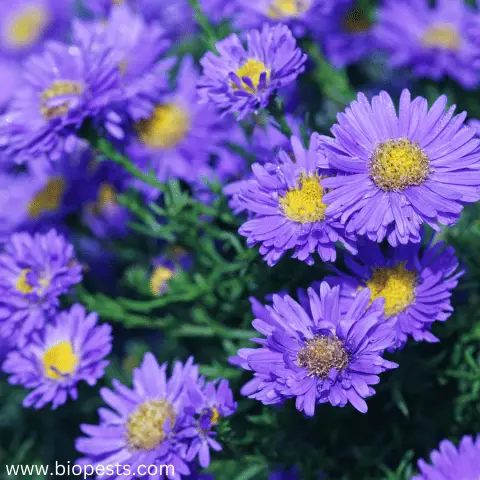
2. Goldenrod
- Description: Known for their bright yellow flowers, goldenrods are a standout in any fall garden.
- Pollinators: Attracts bees, butterflies, and even some beetles.
- Light: Goldenrod flowers thrive best in full sunlight, requiring at least 6-8 hours of direct light daily.
- Soil: They prefer well-drained soil but can tolerate a range of soil types, including sandy and clay soils.
- Watering: goldenrod is quite low-maintenance; water them moderately, allowing the soil to dry out between watering sessions. This hardy plant is perfect for gardeners looking to add vibrant, yellow blooms to their gardens.
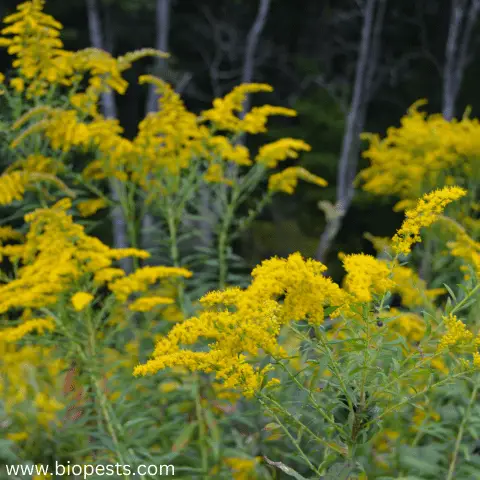
3. Sedum (Stonecrop)
- Description: With its thick leaves and clusters of pink flowers, sedum is both drought-tolerant and attractive.
- Pollinators: Loved by bees and butterflies.
- Light: Sedum, commonly known as stonecrop, is a resilient and low-maintenance plant perfect for gardeners. It thrives in full sunlight but can tolerate partial shade.
- Watering: sedum prefers well-drained soil and needs minimal watering—overwatering can lead to root rot.
- Soil: lastly, this plant flourishes best in sandy or gravelly soil, making it ideal for rock gardens and xeriscaping

4. Joe-Pye Weed
- Description: Joe-Pye Weed is a favorite among gardeners for its beautiful, tall blooms.
- Pollinators: A big hit with butterflies and bees.
- Light: Full sun to partial shade. Aim for at least 6 hours of direct sunlight daily.
- Watering: Consistent moisture. Keep the soil evenly moist, but not waterlogged.
- Soil: Rich, well-drained soil with a slightly acidic to neutral pH.
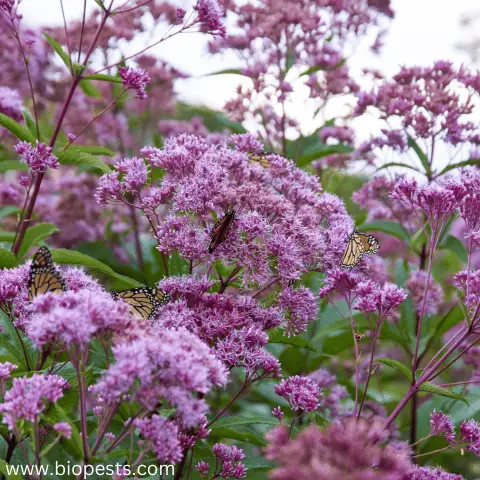
5. Sunflower
- Description: Sunflowers are a favorite among gardeners for their striking appearance and ease of care. These iconic flowers come in various sizes and shades of yellow, orange, and red.
- Pollinators: Bees, butterflies, and even birds are drawn to sunflowers.
- Light: Sunflowers require full sun, which means they need at least 6-8 hours of direct sunlight daily.
- Watering: These plants prefer moderate watering. It’s important to keep the soil moist but not waterlogged, especially during the germination period.
- Soil: Sunflowers grow best in well-draining soil that’s rich in nutrients. A slightly acidic to neutral pH (6.0-7.5) is ideal.
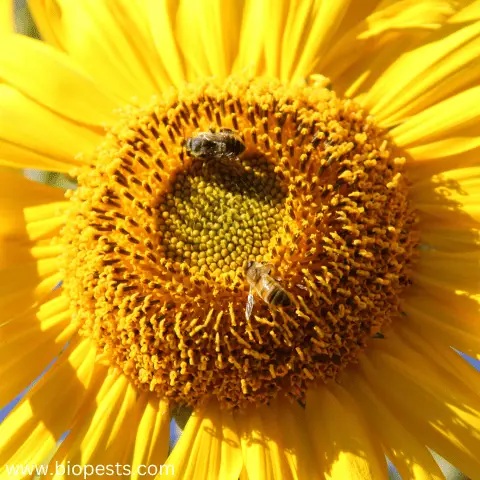
6. Anise Hyssop
- Description: With its aromatic leaves and spikes of purple flowers, this plant adds both fragrance and beauty.
- Pollinators: Attracts bees, butterflies, and hummingbirds.
- Light is crucial; this plant prefers full sun but can tolerate partial shade.
- Watering, ensure the soil is moderately moist but well-drained, as overwatering can lead to root rot.
- Soil requirements: Anise Hyssop flourishes best in rich, loamy soil with a slightly acidic to neutral pH.
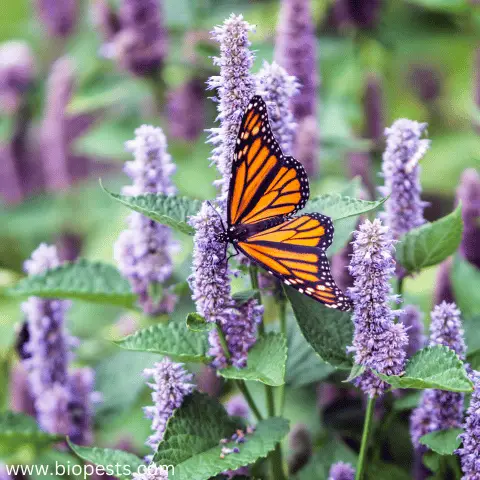
7. Russian Sage
- Description: This plant produces tall spikes of lavender-blue flowers and has a lovely silvery foliage.
- Pollinators: Bees and butterflies can’t resist it.
- Light: Russian Sage thrives in full sun, needing at least 6 hours of direct sunlight daily.
- Watering: Water young plants regularly until established. Once mature, it’s drought-tolerant and requires minimal watering.
- Soil: Prefers well-drained soil with average to poor fertility. Sandy or loamy soil works best.
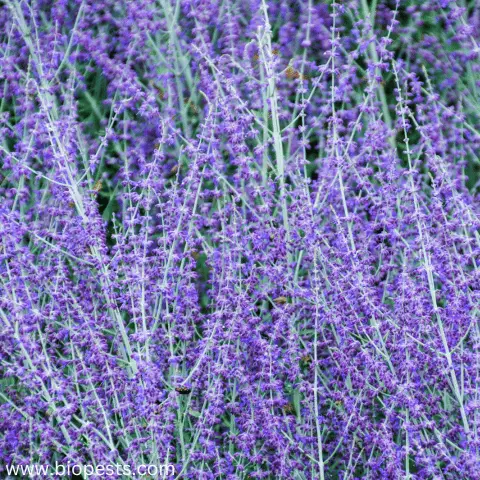
8. Coneflower (Echinacea)
- Description: Known for their daisy-like shape and vibrant colors, coneflowers are a garden staple.
- Pollinators: Bumblebees, butterflies, and other insects are frequent visitors.
- Light: Coneflowers thrive in full sun, requiring at least 6-8 hours of direct sunlight daily.
- Watering: Water your coneflowers moderately. They prefer well-drained soil and can tolerate drought once established, but ensure consistent moisture during the first growing season.
- Soil: These plants do best in rich, well-drained soil with a pH level between 6.0 and 7.0. Amending the soil with compost can enhance growth.
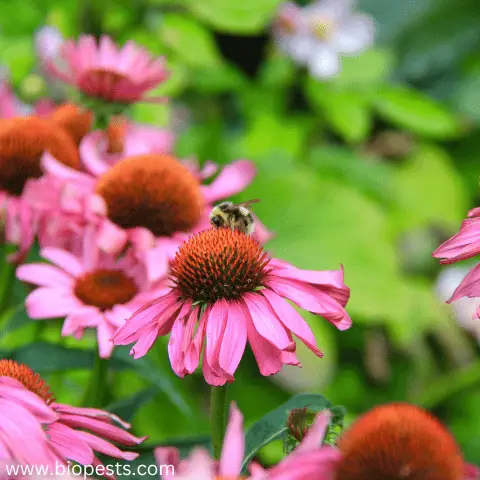
9. Zinnia
- Description: Zinnias come in a variety of bright colors and bloom until frost.
- Pollinators: Attracts a diverse range of pollinators including bees, butterflies, and birds.
- Light: Zinnias thrive in full sunlight, requiring at least 6 hours of direct light daily.
- Soil: they prefer well-drained soil enriched with organic matter. Ensure the soil remains moist but not waterlogged by watering them deeply once or twice a week, allowing the topsoil to dry out between waterings. Perfect for gardeners aiming for vibrant and hardy blooms!
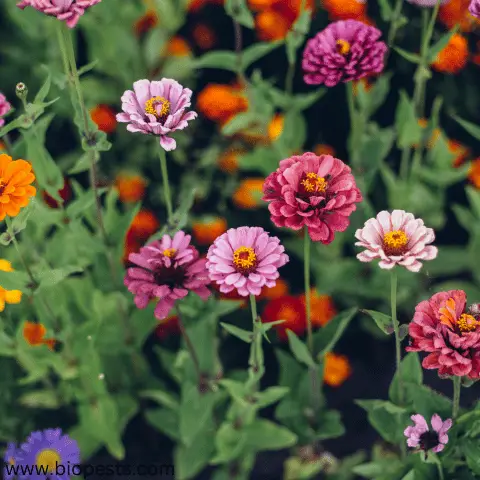
10. Tansy
- Description: These yellow button-like flowers not only add color but also repel some garden pests.
- Pollinators: Mainly attracts bees and some butterflies.
- Light: Tansy is a resilient herb that thrives under specific growing conditions. It prefers full to partial sunlight, which ensures its robust growth and vibrant foliage.
- Watering: When it comes to watering, tansy is drought-tolerant and requires only moderate water; overwatering can lead to root rot.
- Soil: tansy favors well-drained, moderately fertile soil but can adapt to various soil types, making it an excellent choice for diverse gardens. With these conditions met, gardeners can enjoy healthy and flourishing
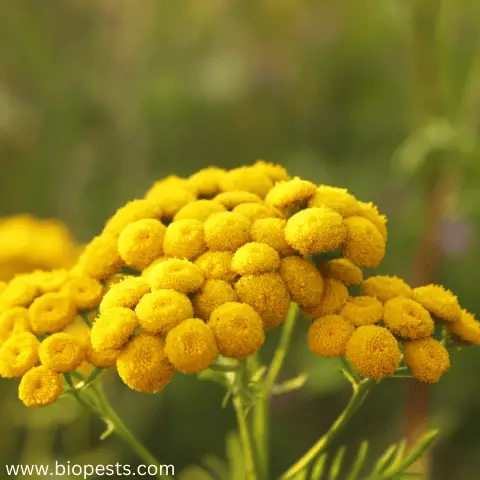
2. Plant Fall-Blooming Flowers
While many flowers tend to bloom in the spring and summer, there are plenty of options for fall-blooming flowers that can provide nectar and pollen for pollinators. Some great choices include asters, goldenrods, sedums, and chrysanthemums. These flowers not only add color and beauty to your garden but also serve as a valuable food source for bees and butterflies during the fall months. (I wrote a list of best pollinator flowers
3. Provide Shelter
Pollinators need shelter just like any other wildlife. By incorporating features such as bee hotels, butterfly houses, or brush piles into your garden, you can create safe havens for pollinators to rest and nest. These shelters can also help protect pollinators from harsh weather conditions as temperatures start to drop in the fall.
Leaving some messiness in your garden or yard may seem counterintuitive at first but can actually benefit local pollinator populations. Dead leaves provide overwintering habitats for insects like butterflies and caterpillars while fallen branches offer shelter for ground-dwelling bees. Embracing a more naturalistic approach to gardening by allowing some areas of your garden to remain untidy can create a welcoming environment for pollinators seeking refuge during the cooler months.
4. Avoid Pesticides
To attract pollinators to your garden, it’s essential to avoid using pesticides that can harm these beneficial insects. Instead of reaching for chemical treatments, consider using natural pest control methods such as companion planting or introducing beneficial insects like ladybugs or praying mantises. By creating a pesticide-free environment, you can make your garden a welcoming place for pollinators.
5. Provide Water Sources
Pollinators need water for hydration and cooling off during hot days. By incorporating water sources such as birdbaths or shallow dishes filled with water into your garden, you can attract a variety of pollinators looking for refreshment. Just be sure to keep these water sources clean and filled regularly so that they remain inviting for thirsty insects.
6. Support Monarch Butterflies
Monarch butterflies are one of the most iconic pollinator species known for their annual migration patterns across North America. To support monarch populations in your area, consider planting milkweed – the sole host plant for monarch caterpillars – along with nectar-rich flowers like coneflowers or black-eyed Susans that adult monarchs feed on during their journey southward in the fall.
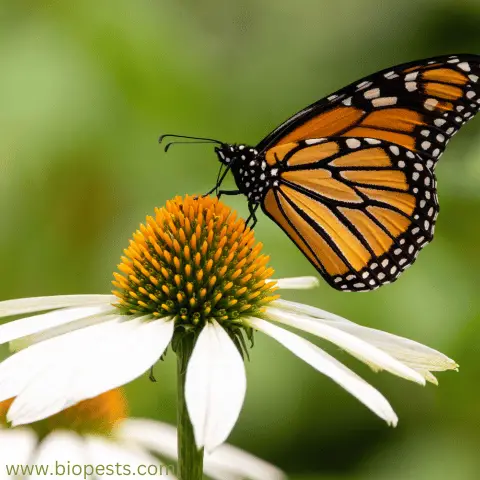
Conclusion
In conclusion, planting fall-blooming flowers for pollinators is not only beneficial for these important creatures but also enhances the beauty of your garden while supporting overall ecosystem health. By creating a pollinator-friendly habitat with elements like food sources, water access points, shelter options, and nesting sites; avoiding harmful pesticides; and leaving some messiness in your garden; you can make a positive impact on local pollinator populations. Let’s work together to ensure that our gardens are thriving spaces where both plants and pollinators can flourish harmoniously throughout every season!
Some of the links above are affiliate links, meaning at no additional cost to you, I will earn a commission if you click through and make a purchase.
